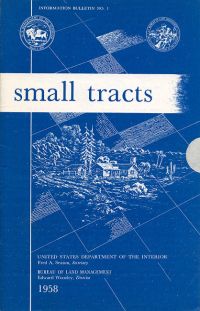

A “Small Tract” parcel authorized under the 1938 Small Tract Act is one of several federal land disposals by which a citizen may obtain a patent to public lands. By federal regulation, a Small Tracts patent may include a specific width right-of-way for roadway and utilities purposes. The 2013 Alaska Supreme Court case McCarrey v. Kaylor changed the common view of what a Small Tract right-of-way is and how to determine its validity. The presentation provided below was made at the 2019 Alaska Surveying & Mapping Conference.
Due to their size of less than 5-acres, a Small Tract parcel has been referred to as a "jack-rabbit homestead". The BLM online database suggests that more than 5,500 Small Tract patents were issued between 1950 and 1984. To provide access to and through the Small Tract parcels, each patent typically included a statement similar to the following: "This patent is subject to a right-of-way not exceeding 33 feet in width, for roadway and public utilities purposes, to be located along the west and south boundaries of said land." In later patents, the ROW width was increased to 50-feet. The question discussed in this report is whether the apparent patent reservation actually exists.
| Date | Documents |
|---|---|
|
1/6/19 |
Small Tract Rights-of-Way: McCarrey v. Kaylor - Presentation Paper (2mb) |
|
2/14/19 |
Small Tract Rights-of-Way Slides - PowerPoint Slides in PDF format (5mb) |
|
2019 |
Small Tract Rights-of-Way Slides w/notes - PowerPoint Slides with notes (5mb) |
|
1953 |
1953 Fairbanks School District Map - Map showing Small Tracts by Classification Order (2mb) |
|
1955 |
Alaska Road Commission 1955 Farm Road Program - Farm and Industrial Roads - Fairbanks District |
|
1950 |
Alaska Road Commission Farm Roads Part 1 - 1950 Anchorage District Farm Roads Program (8mb) |
|
1950 |
Alaska Road Commission Farm Roads Part 2 - 1950 Anchorage District Farm Roads Program (7mb) |
|
1952 |
How to Acquire a Small Tract - Our Public Lands - October Quarterly Issue BLM |
|
1954 |
1954 Small Tracts in Alaska - Our Public Lands - October Quarterly Issue BLM |
|
1958 |
1958 BLM Small Tracts - Small Tracts Bulletin (3mb) |
|
1980 |
1980 BLM Small Tract Guide Book - Guide Book for Manageing Existing Small Tract Areas (7mb) |
|
11/24/64 |
DOI A-30139 Alfred E Koenig - 1964 Colorado Small Tract Appeal Regarding ROW Reservations |
|
7/22/68 |
DOI Solicitor Small Tract ROW - Rights-of-Way in connection with small tracts. |
|
1/10/71 |
DOI Regional Solicitor Opinion - Patent Correction regarding Small Tract |
|
1/11/79 |
DOI Solicitor Small Tract ROW - Reservation of ROW in Small Tract Classifications |
|
4/2/79 |
DOI Solicitor Small Tract Classifications - Small Tract Act Classifications |
|
11/13/63 |
DOI A-29676 Robert Hoopes - Small Tract Appeal |
|
2/25/91 |
DOI BLM Instruction Memorandum - Easements Reserved in Small Tract Act Leases and Patents |
|
7/14/45 |
Act of July 14, 1945 - An Act to provide for the purchase of public lands... |
|
6/1/38 |
Act of June 1, 1938 - To provide for the purchase of public lands for home and other sites. |
|
6/8/54 |
Act of June 8, 1954 - Amendment to Act of June 1, 1938 |
|
10/24/64 |
Small Tract Classification Order 97 Cancellation - Relating to the McCarrey-Kaylor Property |
|
10/31/16 |
BLM SDMS Small Tract Classification Search - Relating to the McCarrey-Kaylor Property |
|
n/a |
HI T12N R3W SM - BLM Historical Index for McCarrey-Kaylor Property |
|
7/14/08 |
MTP S27 12N 3W SM - Master Title Plat for McCarrey-Kaylor Property |
|
4/27/55 |
Small Tract Classification Order 97 - Relating to the McCarrey-Kaylor Property |
|
10/31/16 |
Small Tract Classification 97 Abstract AA093838 - Relating to the McCarrey-Kaylor Property |
|
5/27/10 |
McCarrey v. .Kaylor - Superior Court Complaint - Superior Court |
|
5/27/10 |
McCarrey v. Kaylor Superior Court Memo in Support of TRO - Superior Court - Regarding fencing |
|
6/9/10 |
McCarrey v. Kaylor Superior Court Defendants Opposition to TRO - Superior Court - Regarding fencing |
|
11/11/10 |
McCarrey v. Kaylor Permanent Restraining Order - Superior Court - Against McCarrey - To prevent fencing |
|
4/27/11 |
McCarrey v. Kaylor Appellant Brief - Supreme Court Brief (3mb) |
|
8/29/11 |
McCarrey v. Kaylor Appellee Brief - Supreme Court Brief |
|
9/26/11 |
McCarrey v. Kaylor Appellant Reply Brief - Supreme Court Brief |
|
3/29/13 |
McCarrey v. Kaylor Opinion - Supreme Court Opinion |
|
10/31/13 |
Alaska Bar Association Review - McCarrey v. Kaylor |
|
2013 |
Alaska Law Review - McCarrey v. Kaylor |
|
varies |
Deed Interpretation - Alaska Supreme Court Cases relating to Interpretation of Ambiguous Deeds |
|
6/9/16 |
Small Tract Classifications Alaska Orders Index - Orders Affecting Public Lands in Alaska (3mb) |
|
1949 |
Small Tract Classifications 43 CFR 257 - Code of Federal Regulations |
|
12/6/00 |
Small Tract Classifications Example Termination Order - Terminating a Small Tract Classification (1mb) |